Our eyes, cameras and lenses - Part 1
This is the first part of an article about the vision and how it is processed. Be our or at CCTV cameras.
Cameras and lenses are artificial equivalent closer to the wonderful machine that is our vision.
So, in order to understand and take advantage of them better, we have to first understand how human vision is processed. After all, it is what we use to view images captured by CCTV cameras.
An overview
Our eyes are still much better than the best and most expensive existing CCTV camera. With the size of a ping pong ball, they can take care of about one and a half million simultaneous messages .
Knowledge we absorb daily through our five senses (touch, taste, smell, hearing and vision), 80 % are absorbed by our vision. Therefore , we are essentially visual machines such as CCTV cameras ...
Crystalline
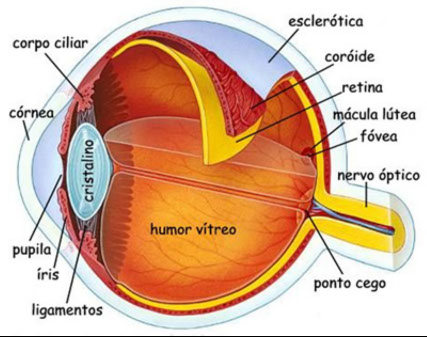
It is the equivalent to the lens of a CCTV camera, surrounded by a ring of small muscles, called ciliary. When relaxed, crystalline flattens; it is when we see from afar.
In order to see up close, these muscles contract , swelling the crystalline.
Thus, our eyes are relaxed when we are seeing more distant things. And that was its main function, because our ancestors needed only see things at a distance - far enough to allow time to perceive and escape from danger or close enough to have a certain accuracy in time to hunt
And this ideal working distance to our eyes is about 20 feets.
But since the invention of writing, our eyes are having problems, because they are being used daily to operate at shorter distances: Books and magazines, computer screens, smart phones, etc., which forces our ciliary muscles to work contracted most of the time - and eventually get tired.
So it is important to interrupt our work regularly and spend a few minutes looking out the window away .
Crystalline works just like a zoom lens with autofocus, and the "keyboard controller" is our brain...
Pupil
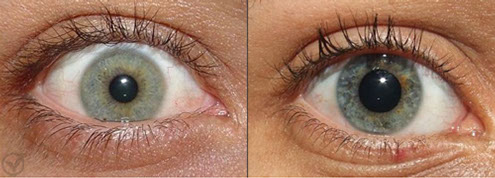 The pupil is located in front of the lens and plays as an autoiris lens controlling the passage of light reaching the crystalline.
The pupil is located in front of the lens and plays as an autoiris lens controlling the passage of light reaching the crystalline.
If it is very bright, it retracts; in low light, it opens, ranging from 3 to 8 mm.
If we are in a dark place that suddenly lights up, our pupil takes about 5 seconds to adapt.
However, if we are in a bright place that suddenly turns dark , our pupils will take about 300 seconds to adapt.
Autoiris lenses make an equivalent process to our pupil; for it they have a control cable connected to the camera, from lens iris receives the opening or closing control signals.

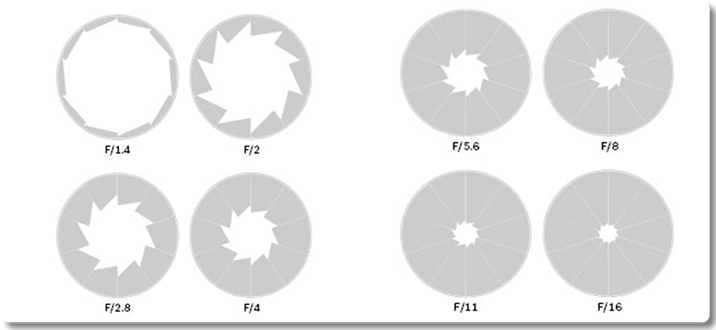
When we go to the eye doctor and have to dilate the pupil, it is as if he " hung our control cable" making our pupil fully open for a few hours. This explains why we couldn't stand bright light and need to wear sunglasses until the effects wear
Retina
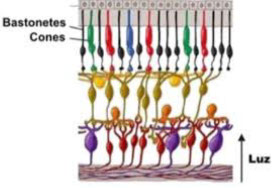
As the crystalline and pupil are equivalent to a CCTV camera lens, our retina is the equivalent of an image sensor.
With about 25/32 in2, it contains two types of receptor cells, called rods and cones .
Cones
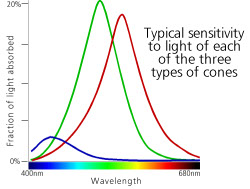 Responsible for our color vision, thay are about 6 to 7 million in each eye and are very concentrated in the central region of the eye, known as the macula. In the center there is the fovea of the macula, with 0.3 mm diameter, where there is a high concentration of cones and no rods.
Responsible for our color vision, thay are about 6 to 7 million in each eye and are very concentrated in the central region of the eye, known as the macula. In the center there is the fovea of the macula, with 0.3 mm diameter, where there is a high concentration of cones and no rods.
They are divided into three different types: red cones (64%), green cones (32%) and blue cones, which represent only 2%.
If you noticed any resemblance to the standard RGB colors (red, green and blue) used in color video system, It's not a mere coincidence ...
Red and green cones are concentrated in the fovea, while blue cones are mostly found outside the fovea.
Cones are also responsible for our view in high resolution (perception of details) and have a much faster response time than the rods, so also responsible for our perception to rapid changes in the image.
Rods
In much larger amount, about 125 million in each eye, they are more sensitive to light than cones (about 100 times), being responsible for the black and white contrast and for our night vision.
Yes, that's right: Under low light we see in black and white (like a camera day-night ...) because under these conditions only rods are catching the light.
This explains why we can move on in poorly lit places, but not read; because the cones, responsible for our vision in detail, are not operative. But rods can still capture enough light for us to see the way.
An interesting fact: Color that causes the least sense of light intensity to the rods is red. For this reason lights of car dashboard instruments (and in a DVR display too) are usually red, otherwise we wouldn't see them well at night with all the car in the dark.
Any other color would "burst" the sensitivity of our rods, making it uncomfortable to be viewed in these conditions.
Distribution of rods and cones
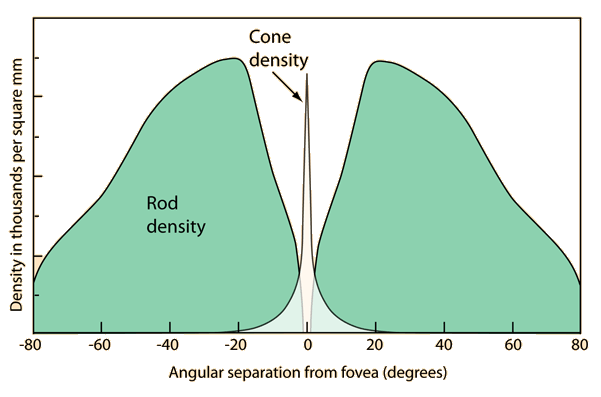 Cones are more concentrated in the center of our eye, at an angle of 20 degrees to the left and 20 degrees to the right.
Cones are more concentrated in the center of our eye, at an angle of 20 degrees to the left and 20 degrees to the right.
That is, our color vision and our perception of details work best when we focus objects at an opening angle of 40 ° .
Rods are more concentrated outside the fovea, working more with our peripheral vision.
So play the role of motion sensors, warning us about something moving to our left or right. It is the famous "eye corner vision."
The angle of view of our eyes
Each eye can see an individual opening angle of 120 to 200 °. As they work together, the intersection region is around 130°.
But due to evolutionary reasons, our peripheral vision is only useful to detect motion and large objects (like a lion coming up on you ...).
Our central angle of view is around 40 to 60°, which corresponds to the angle at which you can view objects without moving your eyes.
This is the same angle of view obtained by an 8 mm lens installed in a fixed camera with a 1/3 "sensor.
Female vision
For some destiny's trap you ended up in a cosmetics shop with yours wife, waiting, "patiently" as she chooses a nail polish.
Some endless minutes later - never less than ten - she approaches with 4 enamel glasses, that you swear are identical, and asks:
- What do you think is the cutest?
You carefully analyzes the four enamels and concludes that they are really identical - you even notice that someone made a mistake by putting labels with different names on them - and, in a cold sweat, think: - Oh, gosh, now what? What to answer?
You can be honest and say: — I don't know, to me are all the same ...
She'll call you blind, insensitive, etc. and you will end up spending the night on the couch.
Sensing that this can happen, you pretend they are different and choose any of the four. However, if you have the misfortune of not choosing the same enamel she has already chosen — yes, she has already made her choice and she is not interested in your opinion, she just want you to confirm the excellent choice of her — you will be called blind, insensitive, etc. and will end up spending the night on the couch.
Besides the joke, why does this happen?
Due to chromosomal differences (XX and XY), men have greater sensitivity to detail and perception of fast movements. The women are better to describe differences between colors.
This explains those strange names of colors that they often use. As Fuchsia, for example. What color is this, anyway?
It is quite clear that, at the time of the caves, the perception of quick movements was very useful for the man hunt — and to escape from danger.
But the fact that women recognize more color nuances made them more likely than men to protect their children, realizing best hidden predators in the shadows or camouflaged to blend with the environment.
This information is useful to determine the sex of the most appropriate vigilant to monitor each situation: environment with a lot of movement or many areas where intruders can lurk.
Animals vision
It's said that dogs and cats see in black and white. Not true, they just do not see same colors as us, because they have only two cones of colors and a much smaller percentage than us, about 10%.
However, their rods can amplify light up to 130 times more than us humans and also have larger pupils, in order to capture more light.
Warm-blooded animal's predators that hunt at night, like the serpent, the owl and the cats in general, can see the infrared spectrum (such as IR cameras).
This is very useful to see their prey, which appear to them detached from the rest of the environment, since their body is at a higher temperature (as in a thermal camera).
Image sensors
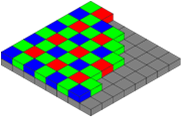 As I mentioned before , image sensor of CCTV cameras is equivalent to our retina.
As I mentioned before , image sensor of CCTV cameras is equivalent to our retina.
Therefore, in order to capture all colors, it also has 3 different types of pixels representing the three cones of our eyes.
At the side, an image sensor, which senses the same three colors of the cones of our eyes.
But, did you notice there is twice as green pixels?
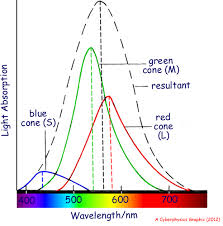 This is necessary because if quantity of pixels would be the same for each color, colors of images captured by a camera would be totally unrealistic, since cones in our eyes exist in different proportions, as we've seen above.
This is necessary because if quantity of pixels would be the same for each color, colors of images captured by a camera would be totally unrealistic, since cones in our eyes exist in different proportions, as we've seen above.
At left , sum of amount of light absorbed by each group of cones gives a curve with a peak between green and yellow colors.
Thus, for an image sensor presents colors we humans can see as real, it has to reproduce this "defect", this non-linearity of our eyes.
That's why there are two green pixels for each red and blue pixel.
But what about the rods of our eyes? How are they represented in an image sensor?
We've seen that colors are defined by groups of 4 pixels, in a 2x2, each pixel is responsible to capture the light intensity corresponding to the color it represents.
Under low light, when camera enters in Night mode, color information is discarded, being each of 4 pixels of each group capturing only brightness of the scene.
This means that there is a four times greater catchment area, thereby increasing sensitivity of image sensor by about 10 times.
For this reason it is common to see specifications like that:
Sensitivity: 0.1 Lux color, 0.01 Lux B&W
Image sensors have a much wider spectrum of vision than our eyes. As the cats, they can see in the spectrum of infrared rays, which could cause a chromatic aberration, affecting color fidelity.
For this reason, it is placed on the image sensor a visible light filter so that, as our eyes, it sees only visible light spectrum.
IR cameras don't use this filter, otherwise the sensor wouldn't see IR light emitted by the infrared cannon attached to the camera.
Thus, IR cameras are very useful for night applications, but they may have color distortion during the day.
For example, as the sun rays have large amount of infrared rays, an IR camera pointed at a clear floor can display images totally blown throughout the day, especially at noon.
One solution to this problem is the called True Day Night cameras, IR cut filter or IRC, used by speed domes and the newer cheap analog CMOS cameras.
They also have a visible light filter which, under low light conditions, is automatically removed from the front of the sensor, allowing it to see infrared rays too.
Image processing
In fact, we do not see with our eyes, we see with our brain. It is who processes received images.
Same function is performed in CCTV cameras by the DSP (Digital Signal Processor) that handles images received by the sensor.
Although image sensors is already trying to mimic our eyes, with doubling green pixels, it still would not be enough for image colors seem to be realistic. It is for DSP to take a finishing touch in the image.
Dynamic range (WDR) of our eyes
A good camera with WDR can view a dynamic range around 60-75 dB, a contrast level ranging from 1:1800 - 1:5600 between lightest and darkest areas of a scene.
Our eyes can see a contrast level of up to 1:10,000 for light scenes. In low light, as when we look at the stars in a dimly lit location, that contrast level can reach 1:1,000,000!
Conclusion of part 1
As we've seen so far, we humans did not invent CCTV cameras, just copied and adapted mechanisms of human and animals vision .
Do you know how many megapixels of resolution our vision has? Find out in the second part of this article.
I will also explain how to leverage all the knowledge acquired over our eyes to design more efficient and ergonomic CCTV systems .
Part 2 - Our eyes, cameras and lenses - Visual acuity and resolution
Mar/2015
Dec/2015
Wanna know when new articles will be published?
Like this article? Leave a comment!
Copyright ©2014 CCTV Institute- All rights reserved
Total or partial reproduction of any content in this website is forbidden except if expressly authorized by the author




